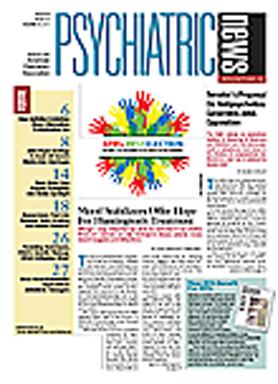People with mental disorders are far more likely to be victims of crimes than perpetrators, but that is hardly the impression left by the media, said three APA Public Psychiatry Fellows at APA’s 2011 Institute on Psychiatric Services in San Francisco in October.
Their presentation came in the 30th anniversary year of the fellowship, which has given 300 young psychiatrists the opportunity to explore new aspects of the field.
People who commit a violent crime are frequently labeled “psychos,” “maniacs,” or “schizophrenics” by headline writers and newscasters, inaccurately linking violence and mental illness in the public mind, said Michael Ketteringham, M.D., M.P.H., a fourth-year resident at New York University.
Surveys show that 61 percent of Americans believe that people with schizophrenia are violent toward others, and 50 percent describe them as unpredictable, said Ketteringham.
While the media may find it quick and easy to pin the blame for violent acts on mental illness, a closer look often reveals that many confounding factors such as social class or substance abuse are likely to form the connection to violence, Ketteringham maintained. He added that many studies connecting violence and mental illness have suffered from selection bias because they draw from populations of jail inmates or from psychiatric patients. However, the latter is only a subset of the mentally ill population and not representative of people with mental illness as a whole, he said.
Some have tried to blame acts of violence that are committed by people with mental illness on deinstitutionalization. Pushing patients into a fragmented, inadequate community mental health system has led to more persons with mental illness ending up on the streets or in prisons, goes this hypothesis.
“However, there has been no increase in violence by mentally ill individuals since deinstitutionalization, although they are 12 times more likely than others to be victims of crimes in cities,” said Ketteringham.
In any case, the effect of blaming violence on mental illness is to increase the already heavy burden of stigma against all people with mental illnesses.
That stigma is reinforced by sensationalized reporting or the exploitation of stock formulas and stereotyping in dramatic shows, said panelist Michael Yao, M.D., a fourth-year resident at the Oregon Health and Science University in Portland. Even children’s programming can portray mentally ill individuals as violent and unpredictable.
Media presentations often confirm and reinforce popular misconceptions about mental illness that only serve to deepen fear and stigma, Yao emphasized.
Mental illness is presented as “concealable,” and thus more frightening. Patients are seen as responsible for their own ailments, which the public also sees as permanent and untreatable.
Even when media stereotypes do not focus on a link between violence and mental illness, they often depart from reality in condescending and stigmatizing ways, said Yao. Thus, if they are not portrayed as homicidal maniacs, people with mental illness are likely to be depicted as childlike innocents or unconventional free spirits, he noted.
Movies and television are not the only avenues for stereotyping mentally ill people, said Public Psychiatry Fellow Christina Khan, M.D., Ph.D., a third-year resident at Stanford University.
A number of rap songs in the 1990s (and one tune by the mainstream rock group Van Halen) refer to “5150,” the section of the California state code that covers involuntary psychiatric confinement, said Khan.
Combating such stigma isn’t easy, said Yao. Normalization strategies, like the National Alliance on Mental Illness’s “In Our Own Voice,” seek to educate the public by bringing them into contact with people who have a mental illness. Such programs have been only modestly successful, but bringing more accurate material to the mass media may do more to shift stigmatizing paradigms.


